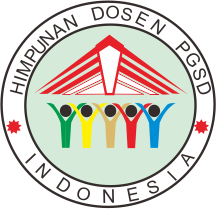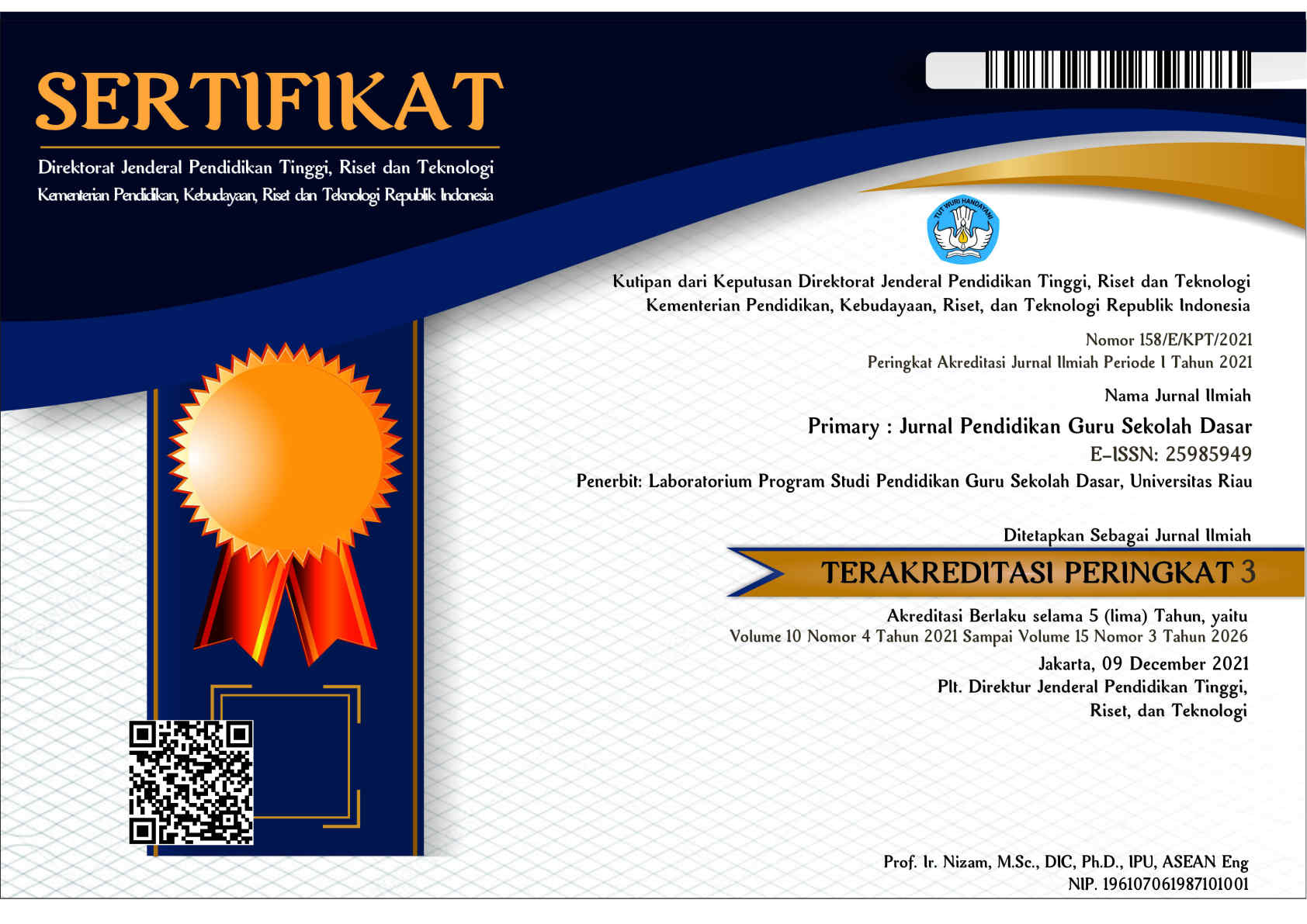The Problem Of Numeration Difficulties (Dyscalculia) In Children: Systematic Literature Review
Abstract
This research aims to find the main themes and research categories regarding numeracy difficulties (Dyscalculia). For the data taken to fulfil the objectives of this research, the author searched for several relevant sources from Google Scholar and Scopus (SAGE et al. & Francis). Four combinations of keywords determined articles; then the articles were included in the data collection, and researchers applied a systematic literature review method. Articles that will be research sources are limited to the last six years. The dominant research methodology of the articles reviewed is qualitative. The four main themes revealed from the qualitative content analysis are dyscalculia, causes of dyscalculia, cases of dyscalculia, and solutions to overcome dyscalculia. Articles are filtered starting from topic description, eligibility criteria and search strategy. The total number of articles reviewed was 198 from different sources, namely Springer, Elsevier, SAGE, Eric, and Taylor & Francis. Then, it was reviewed again to obtain 87 articles. Then, reviewed again according to the theme in the title, 50 articles were found that were most suitable. Of the 50 articles that are most suitable for deeper study, dyscalculia occurs throughout the world. The cause of dyslexia can be due to developmental errors during pregnancy or other factors such as physical defects or the child's habits. The solution offered by the teacher is to use several learning methods and media that are appropriate for the child's condition.
Keywords
Full Text:
PDFReferences
Álvarez; Cristina De-La-Peña. (2018). Dyslexia and Dyscalculia: A Current Systematic Revision from a Neurogenetics Perspective. University Psychologica, 17 (3), 1–11.
Anobile , G., Cicchini, G. M., Gasperini, F., & Burr, D. C. (2018). Typical numerosity adaptation despite selectively impaired number acuity in dyscalculia. Neuropsychologia , 120 , 43–49. https://doi.org/10.1016/j.neuropsychologia.2018.10.006
Avila-Pesantez, D.F., Vaca-Cardenas, L.A., Delgadillo Avila, R., Padilla Padilla , N., & Rivera, L.A. (2019). Design of an augmented reality serious game for children with dyscalculia: A case study. Communications in Computer and Information Science , 895 , 165–175. https://doi.org/10.1007/978-3-030-05532-5_12
Bulthé , J., Prinsen, J., Vanderauwera , J., Duyck, S., Daniels, N., Gillebert, C.R., Mantini, D., Op de Beeck, H.P., & De Smedt, B. (2019). Multi-method brain imaging reveals impaired representations of number as well as altered connectivity in adults with dyscalculia. In NeuroImage (Vol. 190, pp. 289–302). Academic Press Inc. https://doi.org/10.1016/j.neuroimage.2018.06.012
Castaldi, E., Piazza, M., & Iuculano , T. (2020). Learning disabilities: Developmental dyscalculia. In Handbook of Clinical Neurology (Vol. 174, pp. 61–75). Elsevier B.V. https://doi.org/10.1016/B978-0-444-64148-9.00005-3
Cheng, D., Xiao, Q., Chen, Q., Cui, J., & Zhou, X. (2018). Dyslexia and dyscalculia are characterized by common visual perception deficits. Developmental Neuropsychology , 43 (6), 497–507. https://doi.org/10.1080/87565641.2018.1481068
Cheng, D., Xiao, Q., Cui, J., Chen, C., Zeng, J., Chen, Q., & Zhou, X. (2020). Short-term numerosity training promotes symbolic arithmetic in children with developmental dyscalculia: The mediating role of visual form perception. Developmental Science , 23 (4). https://doi.org/10.1111/desc.12910
Cuskelly , M., & Faragher, R. (2019). Developmental Dyscalculia and Down Syndrome: Indicative Evidence. International Journal of Disability, Development and Education , 66 (2), 151–161. https://doi.org/10.1080/1034912X.2019.1569209
De Visscher, A., Noël, M. P., Pesenti, M., & Dormal, V. (2018a). Developmental Dyscalculia in Adults: Beyond Numerical Magnitude Impairment. Journal of Learning Disabilities , 51 (6), 600–611. https://doi.org/10.1177/0022219417732338
De Visscher, A., Noël, M. P., Pesenti, M., & Dormal, V. (2018b). Developmental Dyscalculia in Adults: Beyond Numerical Magnitude Impairment. Journal of Learning Disabilities , 51 (6), 600–611. https://doi.org/10.1177/0022219417732338
Fauzan , A., Andita , CD, Rada, G., Zafirah, A., & Abdullah, AH Bin. (2022). Developing RME-Based Learning Trajectory for Teaching Addition to a Dyscalculia Student in Elementary School. Journal Didactic Mathematics , 9 (1), 39–58. https://doi.org/10.24815/jdm.v9i1.25340
Graven, M., Venkat, H., & Bowie, L. (2022). Analyzing the citizenship agenda in Mathematical Literacy school exit assessments. ZDM - Mathematics Education . https://doi.org/10.1007/s11858-022-01448-1
Haberstroh, S., & Schulte- Körne , G. (2019). Diagnostic und Behandlung der Rechenstörung . Deutsch Arzteblatt International , 116 (7), 107–114. https://doi.org/10.3238/arztebl.2019.0107
Irshad, I., & Yasmin, M. (2022). Feminism and literary translation: A systematic review. Heliyon , 8 (3), e09082. https://doi.org/10.1016/j.heliyon.2022.e09082
Juniawan , EA (2021). Analysis Difficulty Study Mathematics Deep Dyscalculia Students Use Draft Mathematical seen from Error Solving Math Problems . Journal Madani Multidisciplinary (MUDIMA) , 1 , 269–286.
Kilpatrick; Jeremy. (2002). Understanding Mathematical Literacy: The Contribution Of Research .
Laws, M.L., Matejko, A.A., Lozano, M., Napoliello, E., & Eden, G.F. (2022). Dorsal visual stream activity during coherent motion processing is not related to math ability or dyscalculia. NeuroImage : Clinical , 35 . https://doi.org/10.1016/j.nicl.2022.103042
McCaskey, U., Von Aster, M., Maurer, U., Martin, E., O'Gorman Tuura, R., & Kucian , K. (2018). Longitudinal brain development of numerical skills in typically developing children and children with developmental dyscalculia. Frontiers in Human Neuroscience , 11 . https://doi.org/10.3389/fnhum.2017.00629
Michels, L., O'Gorman, R., & Kucian , K. (2018). Functional hyperconnectivity vanishes in children with developmental dyscalculia after numerical intervention. Developmental Cognitive Neuroscience , 30 , 291–303. https://doi.org/10.1016/j.dcn.2017.03.005
Monei , T., & Pedro, A. (2017). A systematic review of interventions for children presenting with dyscalculia in primary schools. Educational Psychology in Practice , 33 (3), 277–293. https://doi.org/10.1080/02667363.2017.1289076
Morsanyi , K., van Bers, BMCW, O'Connor, P. A., & McCormack, T. (2018). Developmental Dyscalculia is Characterized by Order Processing Deficits: Evidence from Numerical and Non-Numerical Ordering Tasks. Developmental Neuropsychology , 43 (7), 595–621. https://doi.org/10.1080/87565641.2018.1502294
Mutlu, A.Y., & Levent Akgün, A. (2017). The Effects of Computer Assisted Instruction Materials on Approximate Number Skills of Students with Dyscalculia. In TOJET: The Turkish Online Journal of Educational Technology (Vol. 16, Issue 2).
Peters, L., Bulthé , J., Daniels, N., Op de Beeck, H., & De Smedt, B. (2018). Dyscalculia and dyslexia: Different behavioral , yet similar brain activity profiles during arithmetic. NeuroImage : Clinical , 18 , 663–674. https://doi.org/10.1016/j.nicl.2018.03.003
PP No. 47 of 2008 concerning Compulsory Education , Republic of Indonesia (2008).
Robinson, P., & Lowe, J. (2015). Literature reviews vs systematic reviews. Australian and New Zealand Journal of Public Health , 39 (2), 103. https://doi.org/10.1111/1753-6405.12393
Rulyansah , A. (2023). Reconnecting Learning: An Educational Alternative For Dyscalculia Children In Elementary School (Vol. 10).
Suartini , NWP (2022). Difficulty Learning from Students Class II Elementary School . Journal of Educational Action Research , 6 (1), 141. https://doi.org/10.23887/jear.v6i1.44635
Torres-Carrión, P., Sarmiento-Guerrero, C., Torres-Diaz, J.C., & Barba- Guamán , L. (2018). Educational math game for stimulation of children with dyscalculia. Advances in Intelligent Systems and Computing , 721 , 614–623. https://doi.org/10.1007/978-3-319-73450-7_58
Uman, L.S. (2007). Systematic reviews and meta-analyses. Clinical Research Methods for Surgeons , February , 311–325. https://doi.org/10.1007/978-1-59745-230-4_18
van Luit, J.E.H. (2019). Diagnostics of dyscalculia. In International Handbook of Mathematical Learning Difficulties: From the Laboratory to the Classroom (pp. 653–668). Springer International Publishing. https://doi.org/10.1007/978-3-319-97148-3_38
Vandervert , L. (2017). The Origin of Mathematics and Number Sense in the Cerebellum: With Implications for Finger Counting and Dyscalculia. Cerebellum and Ataxias , 4 (1). https://doi.org/10.1186/s40673-017-0070-x
Wang, E., Du, C., & Ma, Y. (2017). Old/New Effect of Digital Memory Retrieval in Chinese Dyscalculia: Evidence from ERP. Journal of Learning Disabilities , 50 (2), 158–167. https://doi.org/10.1177/0022219415599344
Wilkey, E.D., Pollack, C., & Price, G.R. (2020). Dyscalculia and Typical Math Achievement Are Associated With Individual Differences in Number-Specific Executive Function. Child Development , 91 (2), 596–619. https://doi.org/10.1111/cdev.13194
Ziadat , A.H. (2022). Sketchnote and working memory to improve mathematical word problem solving among children with dyscalculia. International Journal of Instruction , 15 (1), 509–526. https://doi.org/10.29333/iji.2022.15129a
DOI: http://dx.doi.org/10.33578/jpfkip.v12i5.9925
Refbacks
- There are currently no refbacks.
Copyright (c) 2023 Fatkhul Arifin, Asep Supena

This work is licensed under a Creative Commons Attribution-NonCommercial-ShareAlike 4.0 International License.
____________________________________________________________
Primary: Jurnal Pendidikan Guru Sekolah Dasar
Secretariat
Program Studi Pendidikan Guru Sekolah Dasar
Gedung B1, FKIP Universitas Riau
Kampus Bina Widya Km. 12,5 Simpang Baru Panam
Pekanbaru Riau Indonesia 28293
e-mail : primary@ejournal.unri.ac.id



